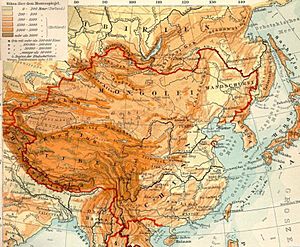Mongolian Plateau facts for kids
Quick facts for kids Mongolian Plateau |
|||||||||
|---|---|---|---|---|---|---|---|---|---|

1903 topographic map of the Qing dynasty depicting the Mongolian Plateau
|
|||||||||
| Chinese name | |||||||||
| Chinese | 蒙古高原 | ||||||||
|
|||||||||
| Mongolian name | |||||||||
| Mongolian Cyrillic | Монголын тэгш өндөрлөг | ||||||||
| Mongolian script | ᠮᠣᠩᠭᠣᠯ ᠤᠨ ᠲᠡᠭᠰᠢ ᠥᠨᠳᠥᠷᠯᠢᠭ |
||||||||
The Mongolian Plateau is a huge, flat area of land in Central Asia. Think of it as a giant, high tableland. It covers about 3.2 million square kilometers (1.2 million square miles). That's a really big space!
This plateau sits between different mountain ranges. To the east, you'll find the Greater Hinggan Mountains. The Yin Mountains are to the south, and the Altai Mountains are to the west. To the north are the Sayan and Khentii mountains.
The land here is mostly dry. It includes the famous Gobi Desert and large areas of dry grasslands called steppes. The plateau is generally high up, about 1,000 to 1,500 meters (3,300 to 4,900 feet) above sea level. The lowest point is in Hulunbuir, while the highest parts are in the Altai Mountains.
Today, the Mongolian Plateau is shared by three countries. It covers all of Mongolia. Parts of it are also in China, including Inner Mongolia and some areas of Xinjiang. In Russia, the plateau makes up Transbaikal, part of Buryatia, and the southern Irkutsk Oblast.
Who Lived on the Mongolian Plateau?
Over many centuries, different groups of people lived on and took control of the Mongolian Plateau. It was a very important place for powerful empires.
Here are some of the groups who lived there, in order:
- The Xiongnu
- The Xianbei
- The Göktürks
- The Tang dynasty
- The Liao dynasty
- The Mongol Empire
- The Yuan dynasty
- The Northern Yuan dynasty
- The Qing dynasty
These groups often had strong leaders and skilled warriors. They shaped the history of this vast region.
How is the Environment Changing?
The environment on the Mongolian Plateau has been changing a lot. Between 1980 and 2010, many lakes in the area got much smaller. This happened because of two main reasons:
- Rising temperatures: The world is getting warmer, and this affects the plateau too.
- Human activities: People have used a lot of lake water for things like mining and farming.
Some lakes have shrunk a lot. For example, Qagaan Nurr and XinKai Lake lost two-thirds of their surface area. Other lakes, like Huangqihai Lake and Naiman Xihu, have completely dried up.
While a few lakes, such as East Juyan Lake and Had Paozi, have actually grown, the total area of all lakes on the plateau has shrunk by about 30%. This is a big change for the environment and the animals that live there.
See also
- Lop Nur
- South Siberian Mountains
- Taklamakan Desert
- Tarim Basin
 In Spanish: Meseta de Mongolia para niños
In Spanish: Meseta de Mongolia para niños

